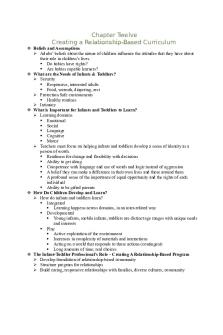Chapter Twelve - Lecture notes 12 PDF

| Title | Chapter Twelve - Lecture notes 12 |
|---|---|
| Author | McKenna Dean |
| Course | Programs For Infants And Young Children |
| Institution | Towson University |
| Pages | 3 |
| File Size | 87.9 KB |
| File Type | |
| Total Downloads | 38 |
| Total Views | 163 |
Summary
Creating a Relationship-Based Curriculum...
Description
Chapter Twelve Creating a Relationship-Based Curriculum Beliefs and Assumptions Adults’ beliefs about the nature of children influence the attitudes that they have about their role in children’s lives. Do babies have rights? Are babies capable learners? What are the Needs of Infants & Toddlers? Security Responsive, interested adults Food, warmth, diapering, rest Protection Safe environments Healthy routines Intimacy What is Important for Infants and Toddlers to Learn? Learning domains Emotional Social Language Cognitive Motor Teachers must focus on helping infants and toddlers develop a sense of identity as a person of worth. Readiness for change and flexibility with decisions Ability to get along Competence with language and use of words and logic instead of aggression A belief they can make a difference in their own lives and those around them A profound sense of the importance of equal opportunity and the rights of each individual Ability to be gifted parents How Do Children Develop and Learn? How do infants and toddlers learn? Integrated Learning happens across domains, in an inter-related way Developmental Young infants, mobile infants, toddlers are distinct age ranges with unique needs and interests Play Active exploration of the environment Increases in complexity of materials and interactions Acting on a world that responds to those actions (contingent) Long amounts of time; real choices The Infant-Toddler Professional’s Role – Creating A Relationship-Based Program Develop foundation of relationship-based community Structure program for relationships Build caring, responsive relationships with families, diverse cultures, community
Use a responsive planning process Create flexible schedule with responsive routines Set up a responsive environment Provide toys, opportunities - individually, culturally, age-appropriate Use a relationship-based approach to guidance Creating a Relationship-Based Community Creating a Relationship-based community Home-like environments that “Connect and nurture people” Homebases Attachment groups The Important of Teachers’ Emotional Connections and Healthy Relationships Making Emotional Connections Develop strong, positive, secure relationships with the children. Be attuned emotionally and physically to children’s cues and communication attempts, reflect on their meaning, and relate as needed by the child. Interact by taking balanced turns (reciprocal interactions)-and matching the pace. Be approachable, accessible, and available to children-both emotionally and physically. Maintain a pleasant and positive emotional tone throughout the day. Respond to children’s distress and intense emotional displeasure calmly-in a way that comforts them-and helps them regulate themselves. Notice, identify, encourage, and show admiration for strengths, interests, and new skills. Appreciate development and differences-help each child feel appreciated for his/her uniqueness. Helping Infants and Toddlers Learn Teachers protect children and help them feel safe and healthy. Teachers help children feel a sense of belonging. Teachers are intentional. Teachers follow children’s lead for what they need. Teachers imitate and encourage the child in an interaction. Teachers scaffold learning in all domains of development A Family and Culture-Centered Program Support the relationship between the child and family. Make family members feel welcome. Involve families in program. Develop a system for daily exchange information. Provide opportunities to express differences, beliefs, values, concerns. Reflect on your cultural beliefs about child rearing. Dialogue with others about differing cultural beliefs. Responsive, Relationship-based Planning The Planning Process Respect Value what the child is trying to do and how the child feels. Admire the child’s feelings, goals, and how the child is learning. Reflect
Observe, think, and feel. How is the child showing you how he or she feels? What are the child’s goals? What is the child learning? How is the child trying to learn it? What does the child need? Relate Be responsive by observing with interest interacting communicating sharing feelings changing the physical environment. Respect: Child’s emotions, efforts, goals, learning, relationships Reflect What am I doing? How am I feeling? What am I learning? Relate What will you do to support my development? Responsive interactions Environment, toys, materials, and experiences...
Similar Free PDFs

Chapter 12 - Lecture notes 12
- 4 Pages

Chapter 12 - Lecture notes 12
- 9 Pages

Chapter 12 lecture notes
- 19 Pages

Chapter twelve patho
- 3 Pages

12 - Lecture notes 12
- 3 Pages

Lecture notes, lecture 12
- 9 Pages

The Twelve Tables - Notes
- 2 Pages

Lecture notes, lecture 12
- 7 Pages

Lab 12 - Lecture notes 12
- 5 Pages
Popular Institutions
- Tinajero National High School - Annex
- Politeknik Caltex Riau
- Yokohama City University
- SGT University
- University of Al-Qadisiyah
- Divine Word College of Vigan
- Techniek College Rotterdam
- Universidade de Santiago
- Universiti Teknologi MARA Cawangan Johor Kampus Pasir Gudang
- Poltekkes Kemenkes Yogyakarta
- Baguio City National High School
- Colegio san marcos
- preparatoria uno
- Centro de Bachillerato Tecnológico Industrial y de Servicios No. 107
- Dalian Maritime University
- Quang Trung Secondary School
- Colegio Tecnológico en Informática
- Corporación Regional de Educación Superior
- Grupo CEDVA
- Dar Al Uloom University
- Centro de Estudios Preuniversitarios de la Universidad Nacional de Ingeniería
- 上智大学
- Aakash International School, Nuna Majara
- San Felipe Neri Catholic School
- Kang Chiao International School - New Taipei City
- Misamis Occidental National High School
- Institución Educativa Escuela Normal Juan Ladrilleros
- Kolehiyo ng Pantukan
- Batanes State College
- Instituto Continental
- Sekolah Menengah Kejuruan Kesehatan Kaltara (Tarakan)
- Colegio de La Inmaculada Concepcion - Cebu






